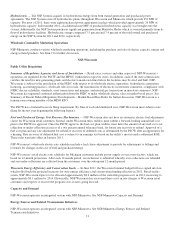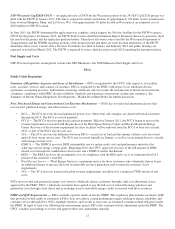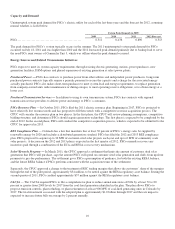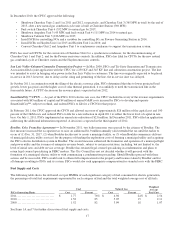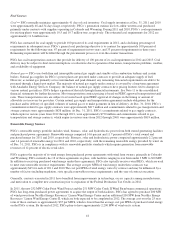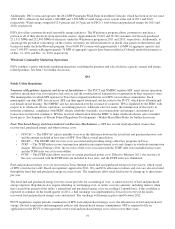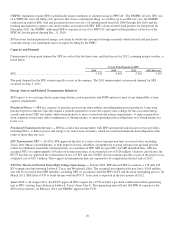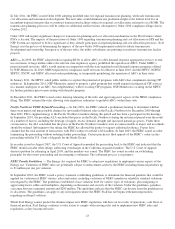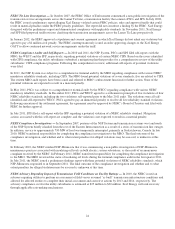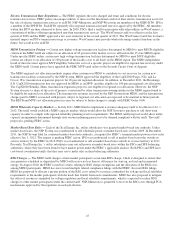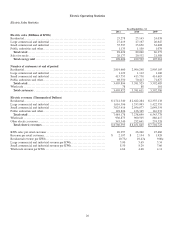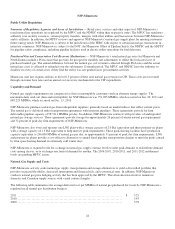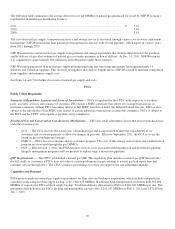Xcel Energy 2011 Annual Report Download - page 32
Download and view the complete annual report
Please find page 32 of the 2011 Xcel Energy annual report below. You can navigate through the pages in the report by either clicking on the pages listed below, or by using the keyword search tool below to find specific information within the annual report.22
Renewable Energy Sources
SPS’ renewable energy portfolio includes wind, solar and hydroelectric power from both owned generating facilities and
purchased power agreements. Renewable energy comprised 8.2 percent and 7.9 percent of SPS’ total owned and purchased
energy for 2011 and 2010, respectively. Solar and hydroelectric power comprised approximately 0.4 percent and 0.3 percent of
renewable energy for 2011 and 2010, respectively, with the remaining renewable energy provided by wind. As of Dec. 31, 2011,
SPS is in compliance with its renewable portfolio standards, which require generation from renewable resources of approximately
3 percent and 10 percent of Texas and New Mexico electric retail sales, respectively.
SPS acquires its wind energy from long-term purchased power agreements with wind farm owners, primarily in the Texas
Panhandle area of Texas and New Mexico. SPS currently has six of these agreements in place, with facilities ranging in size from
under 2 MW to 161 MW. In addition to receiving purchased wind energy under these agreements, SPS also typically receives
wind RECs, which are used to meet state renewable resource requirements. Additionally, SPS is required to purchase another 240
MW of wind energy from qualified generating facilities as defined in the Public Utilities Regulatory Policy Act of 1978. These
purchases are made at the SPP Locational Imbalance Price rather than through long term purchased power agreements. The
average cost per MWh of wind energy under these contracts was approximately $26 and $27 for 2011 and 2010, respectively. The
cost per MWh of wind energy varies by contract and may be influenced by a number of factors including regulation, state specific
renewable resource requirements, and the year of contract execution.
Generally, contracts executed in 2011 have benefited from improvements in technology, excess capacity among manufacturers,
and motivation to complete new construction prior to expiration of the Federal Production Tax Credits in 2012. At the end of
2011 and 2010, SPS had nearly 700 MW of wind energy on its system.
Additionally, in late 2010, SPS signed an agreement to purchase the output of the 161 MW Spinning Spur Wind Ranch which is
expected to be completed in 2012. Wind energy comprised 7.8 percent and 7.6 percent of SPS’ total owned and purchased energy
for 2011 and 2010, respectively.
SPS also offers customer-focused renewable energy initiatives. The Windsource program allows customers in New Mexico to
purchase a portion or all of their electricity from renewable sources. Approximately 1,233 and 1,224 customers purchased 7,005
MWh and 7,162 MWh of electricity under the Windsource program in 2011 and 2010, respectively. Additionally, to encourage
the growth of solar energy on the system, customers are offered incentives to install solar panels on their homes and businesses
under the Solar*Rewards program. Over 70 PV systems with approximately 5 MW of aggregate capacity and 16 PV systems with
less than 1 MW of aggregate capacity have been installed in New Mexico under this program as of Dec. 31, 2011 and Dec. 31,
2010, respectively.
Wholesale Commodity Marketing Operations
SPS conducts various wholesale marketing operations, including the purchase and sale of electric capacity, energy and energy
related products. SPS uses physical and financial instruments to minimize commodity price and credit risk and hedge sales and
purchases. See Item 7 for further discussion.
Summary of Recent Federal Regulatory Developments
The FERC has jurisdiction over rates for electric transmission service in interstate commerce and electricity sold at wholesale,
hydro facility licensing, natural gas transportation, accounting practices and certain other activities of Xcel Energy Inc.’s utility
subsidiaries, including enforcement of NERC mandatory electric reliability standards. State and local agencies have jurisdiction
over many of Xcel Energy Inc.’s utility subsidiaries activities, including regulation of retail rates and environmental matters. In
addition to the matters discussed below, see Note 12 to the accompanying consolidated financial statements for discussion of
other regulatory matters.
FERC Transmission Planning and Cost Allocation — The FERC has approved the open access transmission planning processes
for Xcel Energy and the RTOs serving the NSP System and SPS (MISO and SPP, respectively) set forth in tariffs filed in
compliance with FERC Order 890. The FERC has also approved SPP tariffs providing for the partial regional allocation of the
cost of new transmission facilities.




